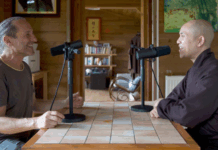A Mindful Day
There are many ways for you to bring mindfulness into your daily life.
Sitting Meditation
I suggest you start each day by sitting down ten minutes to focus on your breath. I have a ten-minute guided sitting meditation video you can listen to every morning until you feel confident to guide yourself correctly. Ten minutes may not sound like much but the philosophy behind this Daily Wellness Empowerment Program is to aim low but aim for consistency. A little bit every day goes a long way. You can do your sitting meditation before or after your Hindu Squats and Hindu Pushups, it’s up to you, but I encourage you to follow this routine every morning, before checking your phone, before interacting with others, and before breakfast. This morning routine is for you. It’s super short: just ten minutes of sitting meditation and a few Hindu squats and Hindu pushups, but it can really help you tune your mind and body for the day, so please give it a try.
Breathing Breaks
Another mindfulness practice you can implement is breathing breaks. Between two activities, or at regular intervals of your choice, pause everything, be still, and enjoy a few mindful breaths.
Like with every practice on this program, I encourage you to set SMART goals for your breathing breaks. If you haven’t printed your DWEP Sheet yet, please do so now, it’s available in the description box below. SMART is an acronym which stands for Specific, Measurable, Action-oriented, and Time-bound. An example of breathing break SMART goals could be, “three mindful breaths before starting my car, before meetings, and before dinner with my family.” You can also use one of the many mindfulness apps out there to remind you to pause and breathe at regular intervals. A few breathing breaks here and there may not sound like much but they will compound and end up making a positive difference in your day.
Mindful Walking
Mindful walking helps you generate the energy of mindfulness wherever you go. To practice mindful walking, tune in the sensations of your breath naturally coming in and out, feel the movements of your legs and the contact between your feet and the ground. Smile. Stand tall. Slow down. And move smoothly. Whenever you get distracted, gently bring your mind back to your breath, your steps, and the present moment, without control or contraction.
Walking mindfully should still feel natural. Sometimes beginners over focus and walk so intentionally that to an outsider it looks as if they’re walking on the moon. Or that they want to show the world that they are more Buddhist than the Buddha.
Please don’t do that. You already know how to walk, and being yourself is good enough. Your main task is to bring some awareness to your walking, without control or contraction. Stay in the flow of the breath, the flow of the steps, and the flow of the present moment, keeping your mind light and open. Mindful walking should feel natural, calming, and enjoyable.
You can bring mindfulness to your steps throughout your daily activities, at home, in your work place, or in the midst of a busy city. You can also create times for mindful walks in nature, and check the Nature part of your Daily Wellness Empowerment Program. And if you bring a good friend along, you’ll be checking the Meaningful Human Connections too. What a DWEP legend.
Mindful Eating
I encourage you to have at least one undistracted meal per day, if possible with your family. No TV in the background, no newspaper on the table, no smart phone in your hand, and definitely no virtual reality glasses on your head. Just the real you enjoying real food with your real family. As you sit down at the dining table, you can follow your breath and recognize how fortunate you are to have food to eat and loved ones to share it with. Before eating, someone can say a few words of appreciation for the cook and everyone, or a short prayer if culturally relevant. To help concentration, it would be great if you and your family could agree to remain sitting in silence for the first ten minutes of the meal. Follow your breath and be aware of your body as you pick up the food, put it in your mouth, and chew it thoroughly before swallowing it. Smile, sit tall, slow down, and move smoothly. Mindful eating is such a yummy practice.
Mindful Conversations
Bringing mindfulness to your conversations will increase the quality of your relationships. When talking with someone, please put your electronics aside and look at them. You don’t want to take anyone’s presence for granted, even if it’s someone you see every day like your mom, dad, partner, or colleague. Everyone has the need to feel seen and valued, and you making time for more mindful human interactions will make a positive difference in everybody’s lives. Being aware of your breath and physical sensations can help you remain more grounded and emotionally aware in your conversations. If you know you’re about to have a difficult conversation with someone, you can also prepare yourself beforehand by breathing mindfully to embrace and calm your feelings, to think about what’s most important for you, and to emit a positive intention for the outcome of the conversation. During the conversation, following your breath can help you regulate your nervous system and increase the quality of your listening. You will be more likely to pick up any urge to interrupt or overreact, and relax into it. Mindfulness of your breath, body, and feelings can help generate space, kindness and understanding for yourself and the other person.
Mindful Whatever-It-Is-You’re-Doing
One way I sometimes guide my mind towards what I’m doing is by mentally saying “enjoying” on my natural in-breath, and the activity I’m doing on the out-breath. For instance breathing in, “enjoying”, breathing out, “sweeping the floor.” Or, in, “enjoying”, out, “walking in the forest”. I just do this for one or a few breaths, to bring my mind into the flow of the breath and the flow of the activity. I use the present continuous tense because life is not a thing but a process. Mindfulness doesn’t call us to grasp the present moment in the way a camera would take a picture but rather to open up to and register change in the way a mirror would reflect a scene. Mindfulness invites us to let go of the past, let go of the future, and enjoy the flow of life in the present moment, with wakefulness and equanimity.
The Most Frequently Asked Question About Mindfulness
After reading to this point, you may ask: “Brother Promise, mindfulness sounds great, but in my life, in my real life, in the real world, I have to think and plan. If I just live in the present, how can I plan my future?”
…
Just kidding! That’s a great question, and there’s a great answer to it, which is that mindfulness doesn’t ask you to never think about the past or the future, but to anchor your mind in the present moment, and when you do need to think, to think calmly and constructively.
We tend to believe that if we think a lot, we must be intelligent, and if we worry a lot, we must be productive. But if we were to pause, step back, and look at our situation more objectively, we would realize that these assumptions are false. It stings to realize this, because we’re so attached to our thoughts, but it’s true. The majority of our thoughts are compulsive, and compulsive thoughts tend to create more problems than they solve.
One of the keys to a happier and more productive life is knowing how to think less compulsively and more consciously. Compulsive thinking is jittery, out of control, and destructive, whereas conscious thinking is calm, controlled, and constructive.
Just as a musician tunes her instrument to produce clear and harmonious notes, you can use mindfulness to tune your nervous system to produce clear and harmonious thoughts. By anchoring your attention in your breath, your body, and the present moment, you can use your mind in a way that brings more value to your life, your studies, and your work.
Please do not just take my word for it. Look at what researchers found.
A meta-analysis conducted by German researchers in 2022 reported that students who practiced mindfulness had significantly higher grades than those who did not.
A 2019 meta-analysis called
found that,
With a mindfulness practice, our mind becomes less of a compulsive tyrant and more of a calm assistant. We see that, most of the time, living deeply and meaningfully in the present moment is the best way we can take care of the future, and when we do need to think and plan, our mindfulness practice helps us do so more consciously and efficiently.
“Mmmmm…. That makes a lot of sense.”
Thanks for asking!
Article republished with permission from mentalhealthrevolution.org























